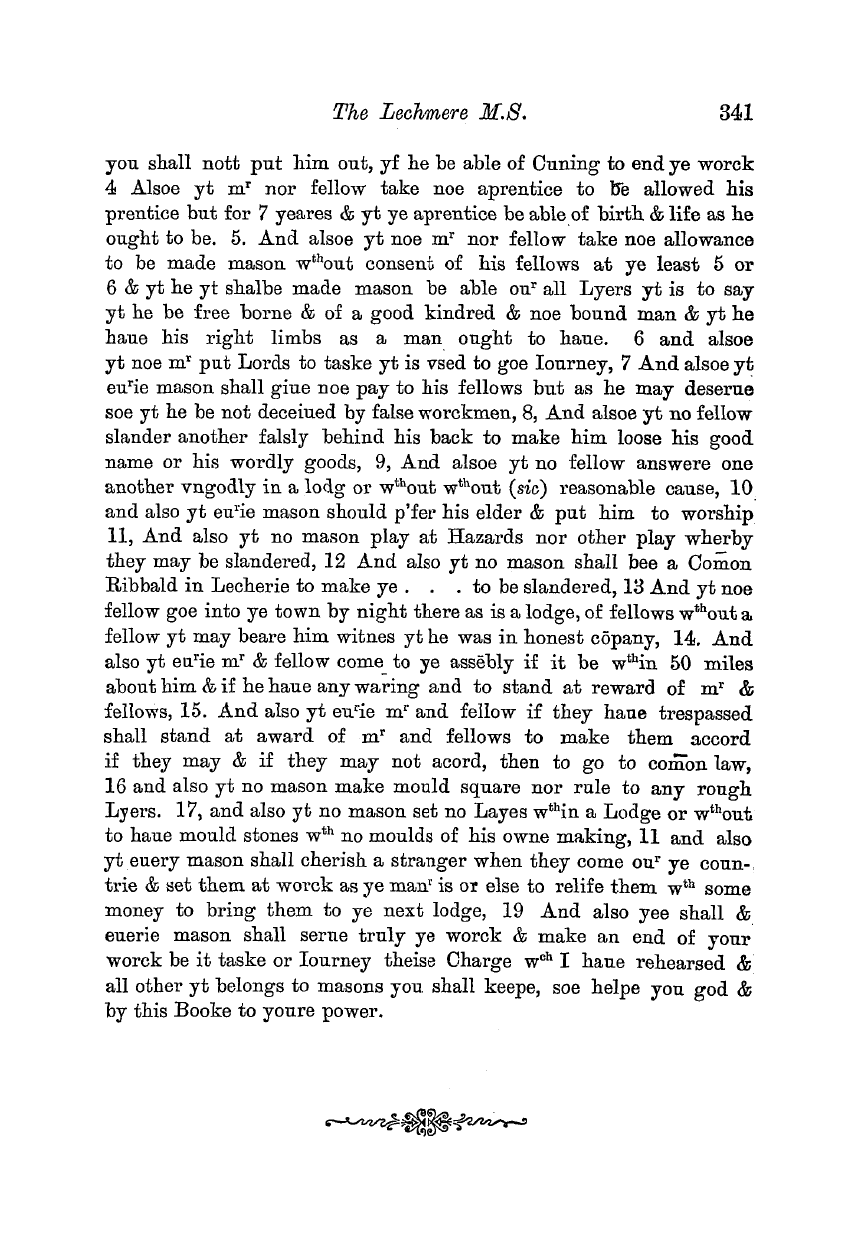Note: This text has been automatically extracted via Optical Character Recognition (OCR) software.
The Legend Of The Introduction Of Masons Into England.
The roof of one of the towers of the monastery at Worcester is mentioned under the year 1041 . * The "beautiful palace at Neomagus " or Nimeguen is burnt in 1049 f . During the reign of Harold various fortifications were made and buildings were dedicated and built . Hereford , in 1055 , J was encircled
with abroad and deep ditch , and fortified with gates and bars . Buildings were added to the monastery at Evesham . § The monastery built by Athelstan at Hereford is burnt ir . 1055 . || And in 1065 , when Harold hid given orders " for the erection of a large building at a place called Portaskith in Wales , " Cradocsonof the King of South Wales marched
there , and on the 24 th August in that year " massacred nearly all the workmen and superintendents , and carried off all the effects which had been transported thither "If— " et operarios fere cunctos , cum illis qui eis praaerant , peremit , et omnia bona , quae ibi congregata fuerant , abstulit . "
Soon after William the Conqueror had been annointed king " he gaveorders to strengthen the forts in different jjlaces . " ** At Nottingham , York , and Lincoln he added to the strength of the castles ; ff and at York the Normans , who occupied the forts , set fire to the houses adjacent to them , fearing that they might be of use to the Danes in filling up the trenches . ^!
Morkar and others having retired to the Island of Ely to winter . §§ only surrendered to King William when he blocked up every outlet on the eastern side of the island , " and commanded a bridge of two miles in length to be constructed on the western side . " Henry of Huntingdon , who flourished in 1154 , informs us that the fort which
was then constructed " stands at the present time , "jjj | and it was under somewhat similar circumstances in 1140 , ^ f ^ f when the Bishop of Ely had retired to this island , that King Stejahen passed over on a bridge of boats which he had caused to be constructed . A wooden church *** is jarobably referred to in 1080 ( at Durham ) ,
for we are told that " they set fire to the walls and roof " —( ecclesiaa tecto parietibusque ignem imposuere ) . But scanty information is given of all the building operations carried on under the early Norman kings . Robert de Belesme , Earl of ShreAvsbury , so renowned for his skill in all matters ( including building ) relating to war , in 1101 , we are told , "began to fortify with
Note: This text has been automatically extracted via Optical Character Recognition (OCR) software.
The Legend Of The Introduction Of Masons Into England.
The roof of one of the towers of the monastery at Worcester is mentioned under the year 1041 . * The "beautiful palace at Neomagus " or Nimeguen is burnt in 1049 f . During the reign of Harold various fortifications were made and buildings were dedicated and built . Hereford , in 1055 , J was encircled
with abroad and deep ditch , and fortified with gates and bars . Buildings were added to the monastery at Evesham . § The monastery built by Athelstan at Hereford is burnt ir . 1055 . || And in 1065 , when Harold hid given orders " for the erection of a large building at a place called Portaskith in Wales , " Cradocsonof the King of South Wales marched
there , and on the 24 th August in that year " massacred nearly all the workmen and superintendents , and carried off all the effects which had been transported thither "If— " et operarios fere cunctos , cum illis qui eis praaerant , peremit , et omnia bona , quae ibi congregata fuerant , abstulit . "
Soon after William the Conqueror had been annointed king " he gaveorders to strengthen the forts in different jjlaces . " ** At Nottingham , York , and Lincoln he added to the strength of the castles ; ff and at York the Normans , who occupied the forts , set fire to the houses adjacent to them , fearing that they might be of use to the Danes in filling up the trenches . ^!
Morkar and others having retired to the Island of Ely to winter . §§ only surrendered to King William when he blocked up every outlet on the eastern side of the island , " and commanded a bridge of two miles in length to be constructed on the western side . " Henry of Huntingdon , who flourished in 1154 , informs us that the fort which
was then constructed " stands at the present time , "jjj | and it was under somewhat similar circumstances in 1140 , ^ f ^ f when the Bishop of Ely had retired to this island , that King Stejahen passed over on a bridge of boats which he had caused to be constructed . A wooden church *** is jarobably referred to in 1080 ( at Durham ) ,
for we are told that " they set fire to the walls and roof " —( ecclesiaa tecto parietibusque ignem imposuere ) . But scanty information is given of all the building operations carried on under the early Norman kings . Robert de Belesme , Earl of ShreAvsbury , so renowned for his skill in all matters ( including building ) relating to war , in 1101 , we are told , "began to fortify with




























































